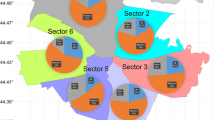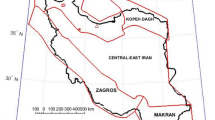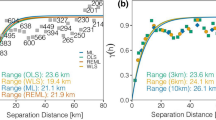Abstract
Seismic risk assessment of lifeline networks or building portfolios requires the quantification of spatial correlation of ground motion intensity over a region during an earthquake event. In this paper, the spatial correlation of vertical spectral accelerations (SAs) at single and multiple periods is studied. In the first part, the spatial correlations of vertical SAs at eight periods in the range of 0.0–3.0 s are investigated. The geostatistical analysis is performed to compute the spatial correlations of SAs using records compiled from ten earthquake events occurred in California, Japan, Taiwan, and Mexico. The results show that the spatial correlations of the vertical SAs at short periods are dependent on the regional site conditions indicated with the spatial correlation of shear wave velocity in the top of 30 m (Vs30). However, the effect of the correlation of Vs30 on the correlation of the vertical SAs decreases as the spectral period increases. A simple predictive model is proposed to quantify the correlation ranges of the vertical SAs considering regional site conditions. The proposed model is compared with the models presented for horizontal SAs. The comparison shows that the correlation ranges of horizontal SAs are generally larger than those of the vertical ones. As an illustrative example, seismic performance of a hypothetical bridge network is studied with different ranges of spatial correlations. The results indicate that ignoring spatial correlation may significantly affect the exceedance probability for spatially distributed engineering demand parameters of bridges in the network. In the second part, the multivariate spatial correlation is investigated using linear model of coregionalization (LMC) approach. Based on the correlation estimates obtained from geostatistical analysis, a predictive model is proposed to simulate vertical SAs at multiple periods and different sites.













Similar content being viewed by others
References
Abrahamson N, Schneider JF, Stepp JC (1991) Spatial coherency of shear waves from the Lotung, Taiwan large-scale seismic test. Struct Saf 10(1–3):145–162
Baker JW, Cornell CA (2006) Correlation of response spectral values for multicomponent ground motions. Bull Seismol Soc Am 96(1):215–227
Bastami M (2007) Seismic reliability of power supply system based on probabilistic approach. PhD thesis, Kobe University, Japan
Bazzurro P, Luco N (2007) Effects of different sources of uncertainty and correlation on earthquake-generated losses. Aust J Civ Eng 4(1):1–14
Boore DM, Gibbs JF, Joyner WB, Tinsley JC, Ponti DJ (2003) Estimated ground motion from the 1994 Northridge, California, earthquake at the site of the Interstate 10 and La Cienega Boulevard bridge collapse, West Los Angeles, California. Bull Seismol Soc Am 93(6):2737–2751
Bozorgnia Y, Campbell KW (2016) Vertical ground motion model for PGA, PGV, and linear response spectra using the NGA-West2 database. Earthquake Spectra 32(2):979–1004
Button MR, Cronin CJ, Mayes RL (2002) Effect of vertical motions on seismic response of highway bridges. J Struct Eng 128(12):1551–1564
Campbell KW, Bozorgnia Y (2014) NGA-West2 ground motion model for the average horizontal components of PGA, PGV, and 5% damped linear acceleration response spectra. Earthquake Spectra 30(3):1087–1115
Costa C, Silva V, Bazzurro P (2018) Assessing the impact of earthquake scenarios in transportation networks: the Portuguese mining factory case study. Bull Earthq Eng 16(3):1137–1163
Cressie N, Hawkins DM (1980) Robust estimation of the variogram: I. J Int Assoc Math Geol 12(2):115–125
Du W, Wang G (2013) Intra-event spatial correlations for cumulative absolute velocity, arias intensity, and spectral accelerations based on regional site conditions. Bull Seismol Soc Am 103(2A):1117–1129
Elgamal A, He L (2004) Vertical earthquake ground motion records: an overview. J Earthq Eng 8(05):663–697
Esposito S, Iervolino I (2011) PGA and PGV spatial correlation models based on European multievent datasets. Bull Seismol Soc Am 101(5):2532–2541
Esposito S, Iervolino I (2012) Spatial correlation of spectral acceleration in European data. Bull Seismol Soc Am 102(6):2781–2788
Garakaninezhad A, Bastami M (2017) A novel spatial correlation model based on anisotropy of earthquake ground-motion intensity. Bull Seismol Soc Am 107(6):2809–2820
Garakaninezhad A, Bastami M, Soghrat MR (2017) Spatial correlation for horizontal and vertical components of acceleration from northern Iran seismic events. J Seismol 21(6):1505–1516
Goda K, Atkinson GM (2010) Intraevent spatial correlation of ground-motion parameters using SK-net data. Bull Seismol Soc Am 100(6):3055–3067
Goda K, Hong H (2008) Spatial correlation of peak ground motions and response spectra. Bull Seismol Soc Am 98(1):354–365
Goovaerts P (1997). Geostatistics for natural resources evaluation. Oxford University Press on Demand
Goulard M, Voltz M (1992) Linear coregionalization model: tools for estimation and choice of cross-variogram matrix. Math Geol 24(3):269–286
Gulerce Z, Erduran E, Kunnath SK, Abrahamson NA (2012) Seismic demand models for probabilistic risk analysis of near fault vertical ground motion effects on ordinary highway bridges. Earthq Eng Struct Dyn 41(2):159–175
Hong H, Zhang Y, Goda K (2009) Effect of spatial correlation on estimated ground-motion prediction equations. Bull Seismol Soc Am 99(2A):928–934
Jayaram N, Baker JW (2008) Statistical tests of the joint distribution of spectral acceleration values. Bull Seismol Soc Am 98(5):2231–2243
Jayaram N, Baker JW (2009) Correlation model for spatially distributed ground-motion intensities. Earthq Eng Struct Dyn 38(15):1687–1708
Kunnath SK, Erduran E, Chai Y, Yashinsky M (2008) Effect of near-fault vertical ground motions on seismic response of highway overcrossings. J Bridg Eng 13(3):282–290
Lee R, Kiremidjian AS (2007) Uncertainty and correlation for loss assessment of spatially distributed systems. Earthquake Spectra 23(4):753–770
Loth C, Baker JW (2013) A spatial cross-correlation model of spectral accelerations at multiple periods. Earthq Eng Struct Dyn 42(3):397–417
Papazoglou A, Elnashai A (1996) Analytical and field evidence of the damaging effect of vertical earthquake ground motion. Earthq Eng Struct Dyn 25(10):1109–1138
Pavel F, Vacareanu R (2016) Spatial correlation of ground motions from Vrancea (Romania) intermediate-depth earthquakes. Bull Seismol Soc Am 107(1):489–494
Saadeghvariri MA, Foutch D (1991) Dynamic behaviour of R/C highway bridges under the combined effect of vertical and horizontal earthquake motions. Earthq Eng Struct Dyn 20(6):535–549
Shakib H, Fuladgar A (2003) Response of pure-friction sliding structures to three components of earthquake excitation. Comput Struct 81(4):189–196
Sokolov V, Wenzel F (2013) Further analysis of the influence of site conditions and earthquake magnitude on ground-motion within-earthquake correlation: analysis of PGA and PGV data from the K-NET and the KiK-net (Japan) networks. Bull Earthq Eng 11(6):1909–1926
Sokolov V, Wenzel F, Wen K-L, Jean W-Y (2012) On the influence of site conditions and earthquake magnitude on ground-motion within-earthquake correlation: analysis of PGA data from TSMIP (Taiwan) network. Bull Earthq Eng 10(5):1401–1429
Wang G, Du W (2013) Spatial cross-correlation models for vector intensity measures (PGA, I a, PGV, and SAs) considering regional site conditions. Bull Seismol Soc Am 103(6):3189–3204
Wang M, Takada T (2005) Macrospatial correlation model of seismic ground motions. Earthquake Spectra 21(4):1137–1156
Weatherill G, Silva V, Crowley H, Bazzurro P (2015) Exploring the impact of spatial correlations and uncertainties for portfolio analysis in probabilistic seismic loss estimation. Bull Earthq Eng 13(4):957–981
Yu C-P (1996). Effect of vertical earthquake components on bridge responses
Zahrai S, Heidarzadeh M (2007) Destructive effects of the 2003 bam earthquake on structures. Asian J Civil Eng (Build Hous) 8(3):329–342
Acknowledgments
The authors would like to acknowledge the International Institute of Earthquake Engineering and Seismology (IIEES) for its help in providing research documents and Grant Number 7520.
Author information
Authors and Affiliations
Corresponding author
Additional information
Data and resources
The ground motion records used in this study were obtained from the Pacific Earthquake Engineering Research (PEER) Center’s NGA database (https://peer.berkeley.edu/thrust-areas/data-sciences/databases, last accessed July 2018).
Publisher’s note
Springer Nature remains neutral with regard to jurisdictional claims in published maps and institutional affiliations.
Rights and permissions
About this article
Cite this article
Garakaninezhad, A., Bastami, M. Intra-event spatial correlation model for the vertical component of response spectral accelerations. J Seismol 23, 853–867 (2019). https://doi.org/10.1007/s10950-019-09838-x
Received:
Accepted:
Published:
Issue Date:
DOI: https://doi.org/10.1007/s10950-019-09838-x




